Updated: Mar. 20, 2019
Next Project›
Family Handyman
A pro explains common repair and maintenance for motorcycles and ATVs that you can do yourself. Save money by replacing CV boots, cleaning and lubing chains and cables, and performing other basic tasks.
By the DIY experts of The Family Handyman Magazine
Fill your tires to the ATV manufacturer’s recommended pressure (it’s printed on a label stuck to the machine and in your owner’s manual), never to the maximum pressure shown on the tire sidewall.
Many ATV owners have lost their low-pressure tire gauge and use an auto tire gauge instead. Big mistake! It won’t give you an accurate reading. And according to our pro, Josh Fischer, (the owner of Unlimited Motor Sports Repair), most customers overfill their tires, sometimes by as much as 20 to 30 lbs.
That reduces traction and increases the “bounce” factor that could throw you from the machine. In 2006, ATV accidents in the United States resulted in an estimated 882 deaths and 146,600 visits to the emergency room. Don’t be the next statistic. Inflate your tires to the proper pressure. If you’re thinking about buying an ATV, check out these tips on buying a used ATV.
New CV boots and bands are available at dealers or online.
Cut the retaining bands with side cutters and slice the old boot lengthwise with a utility knife to remove it. Clean the joint in degreaser until you can see the retaining clip. Compress or expand the C-clip (depending on the style), and pop the joint off the axle.
Soak the disassembled joint in degreaser, scrub the parts with a toothbrush, rinse with clean degreaser and wipe the parts dry. Slide the boot over the axle shaft and crimp the band clamp. Then fill the joint with new grease.
Slide the boot over the axle shaft and crimp the band clamp. Then fill the joint with new grease.
Slip the large end of the boot over the joint. Burp the air out of the boot and crimp the remaining band. Tighten just enough to prevent the boot from rotating.
Constant velocity (CV) boots keep the lubricating grease inside the joint and the dirt out—until they crack. Then you have to replace them—and fast! Once they’re open to the environment, the grease attracts dirt, which grinds up the metal parts in no time. Instead of replacing an $18 boot, you’ll be buying the entire joint at $125 a pop.
It’s easy to check the condition of the CV boots. Just look for fresh grease around the pleats. If you see any, the boot is toast.
Replacing a CV boot is fairly simple maintenance, but you’ll have to remove the axle shaft from the machine. To do that, you’ll have to jack up the machine and support it with jack stands (see your service manual for jacking and support locations). Then remove the wheel and the axle nut.
Then remove the wheel and the axle nut.
Next, remove the axle from the differential. Most axle styles pop out with a crowbar, but some require a special procedure, so refer to your service manual. Service manuals are worth the investment if you plan to do your own work (check the dealer or online for prices and availability).
You can buy individual CV boots, but as long as you have the axle shaft out of the machine, it’s best to replace both of them at once. You’ll also need a band installation tool. Buy one from your local dealer, or check online (search “ATV tools and parts”). Once the axle is out, follow the boot replacement procedure shown.
Remove the foam filter and wipe any debris from the outside. Then dunk the filter in the cleaning solution for the recommended time. Squeeze out the excess solution. Rinse the filter with water and let it dry.
Pour fresh oil on the cleaned filter element. Then squeeze the foam to spread the oil into the pores. Reinstall it on the carburetor.
Then squeeze the foam to spread the oil into the pores. Reinstall it on the carburetor.
Most of you operate your ATVs in dirty conditions. That’s fine; they’re designed for that. But you have to keep the air filter clean. According to Josh, just about every machine he works on has a seriously clogged filter. A dirty filter lowers your gas mileage and causes poor engine performance. Cleaning the filter is messy, but anybody can do it.
Buy an air filter cleaning kit from your dealer. It contains a bottle of cleaning solution and a spray can of filter oil. You’ll also need a plastic cleaning tub, rags, a bucket of soapy water and chemical-resistant gloves.
Dunk the brush in degreaser and slide it up and down the chain. Rotate the chain and repeat until you’ve cleaned the entire chain. Rinse with clean degreaser and sponge it dry with a rag.
Use a Grunge Brush or similar tool to clean gunk off a motorcycle chain.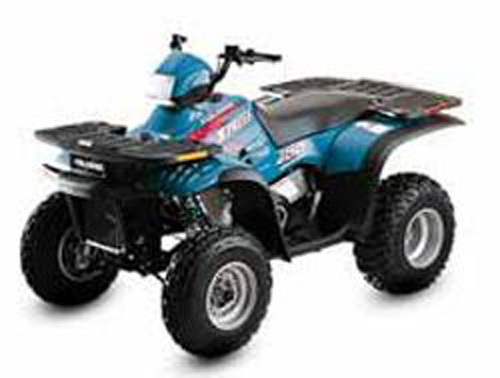
Spray the sprocket side of the chain links, not the outside. Then take the bike for a spin. Centrifugal force will spin the lube deep into the links for complete lubrication.
Cleaning and lubing your motorcycle chain takes only a few minutes and can dramatically increase the life of the chain. Many bike owners do it wrong. Lube needs to be applied to the part of the chain that meshes with the cogs. If you apply it to the outside of the chain, centrifugal force will throw it off before it can penetrate to the chain’s innards. Josh recommends the Grunge Brush (available through our affiliation with Amazon.com) to scrub the crud off the chain (see photo).
Disconnect the stud end of the cable from the lever. Then attach the cable luber. Insert the spray straw into the opening on the luber and inject the lube under pressure to force it into the cable.
Josh replaces a lot of cables that could last much longer with periodic lubrication. And, with replacements costing $20 and up, regular lubrication is just plain smart. Lubricate the cables twice per season. It’s easy to do, but you’ll need this special lubrication tool for an effective job. Buy it (and a can of spray cable lube) at your dealer or online.
And, with replacements costing $20 and up, regular lubrication is just plain smart. Lubricate the cables twice per season. It’s easy to do, but you’ll need this special lubrication tool for an effective job. Buy it (and a can of spray cable lube) at your dealer or online.
This simple drain-and-refill procedure should be done regularly. But many owners neglect it, resulting in huge repair bills. Refer to your owner’s manual for recommended change intervals and the proper type of lube oil.
Have the necessary tools for this DIY project lined up before you start—you’ll save time and frustration.
You’ll also need a low-pressure tire gauge, a sidecutter, a banding tool, a crowbar, rubber gloves, and a chain-cleaning brush.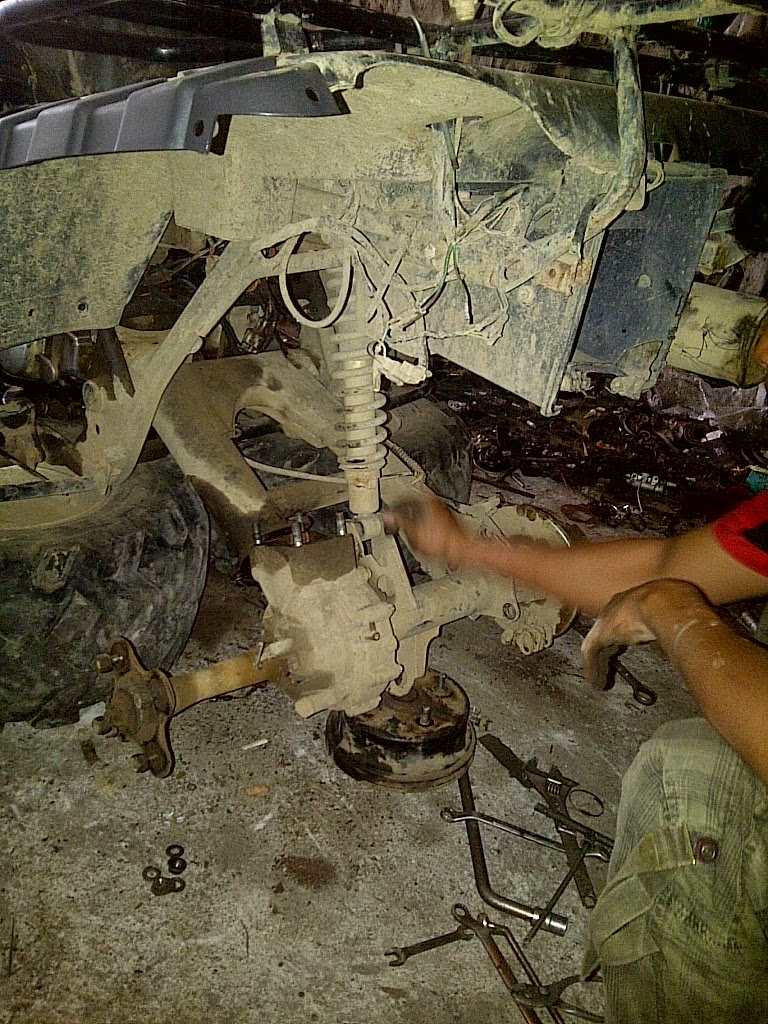
Avoid last-minute shopping trips by having all your materials ready ahead of time. Here’s a list.
Originally Published: November 27, 2018
ⓘ
Cracks and scratches on your ATV plastics are bound to happen sooner or later. You could maintain and clean your ATV after every use, and still, you’ll end up with faded or scratched up plastic eventually.
To some people, scuffed up plastic on their quad is not a big deal. I mean, it’s not like it affects performance, handling, or anything important anyways. But there’s just something about the way it makes the machine look that I don’t like. So I went ahead and found the best ways to fix some of the most common ATV plastic damage you’ll encounter.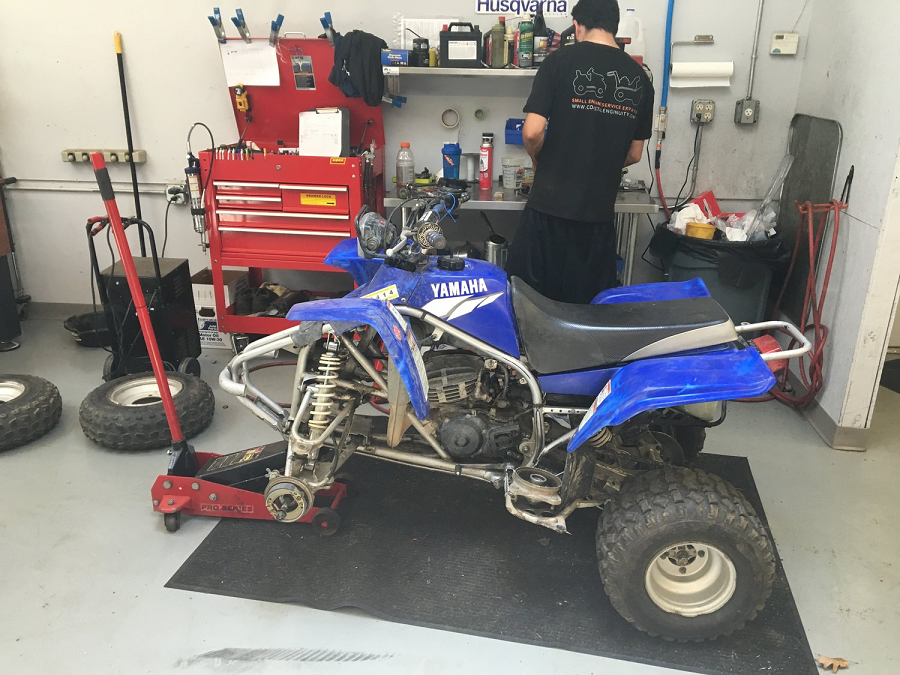
It’s a good idea to know why plastic fades to help you understand why the methods here work for restoring faded plastic. Basically, plastic starts to look faded because the oils in the plastic evaporate over time. The evaporation of oils in the plastic is sped up when the plastic sits in the sun for long periods of time.
Plastic is made from refined oil, and as the oil in the top layer of the plastic evaporates, the plastic is weakened and looks faded. Your plastics become more prone to cracks too the more you let it fade and weaken.
You could simply sand down the top layer of plastic, until you get to the part where the oil hasn’t evaporated yet. Then buff it out until it looks nice and new. But with this approach, you’re still weakening the plastic because you are actually removing layers of the plastic each time you do this.
Another method I’ve tried, is using a heat gun to help bring the oil in the plastic to the surface. This does work pretty good and makes the plastic look nice. But again, you’re not actually restoring oil to the plastic so over time, the plastic is getting weaker and weaker.
But again, you’re not actually restoring oil to the plastic so over time, the plastic is getting weaker and weaker.
My preferred method, and what I recommend you try first. Is to get this Premium Plastic Restorer From Car Guys found here on Amazon. This way you’re not removing plastic, oil, or anything else from your ATV parts. In fact, this stuff is actually adding additives to the plastic to help get them to the condition they were in when they were brand new. This particular plastic restorer also has some nice UV protection to help keep the plastic from drying out and fading in the future.
Keep in mind, this is not to repair scratches or anything like that. It is specifically to restore dry faded plastic. There are some other brands out there that will do the same thing, I’ve just had the most luck with this one. To be honest, this is way easier than sanding or using a heat gun anyway, and I don’t have to worry about the structural integrity of the plastic being compromised.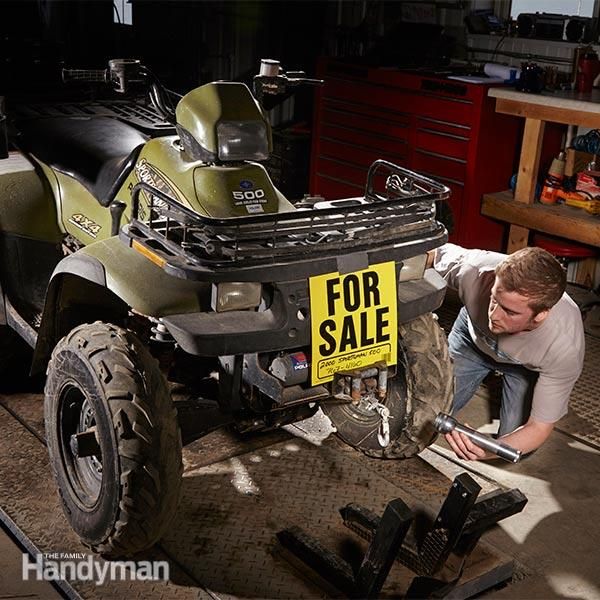
There are two types of scratches you’ll encounter most often, light scratches or deep scratches. Light scratches are the ones caused by branches or bushes hitting the plastics and leaving little visible marks. A lot of people don’t even bother with these types of scratches, and just chalk it up to wear and tear. But for someone spending a lot of money on a quad or ATV, I can understand wanting to remove even the littlest of scratches.
The best way I’ve found for removing light scratches is to go with some 1500 Grit Wet Sandpaper. Just use the sand paper over the areas with scratches and buff it out when you’re done. You could finish up with a coat of the plastic restorer I talked about above to make it look brand new.
Using wet sand paper could even work for medium to deep scratches, but I don’t like removing that much plastic from my ATV parts. For the deeper scratches you end up having to start with 400 grit or worse, and work your way up to 1500 grit to get a smooth surface. For me, it’s not worth all the time and energy sanding to just end up compromising the integrity of the plastics. Don’t forget, the more plastic you sand away, the easier they will crack.
For me, it’s not worth all the time and energy sanding to just end up compromising the integrity of the plastics. Don’t forget, the more plastic you sand away, the easier they will crack.
So for deeper scratches I’ll use a plastic bonder/filler. My go-to is this JB Weld Plastic Bonder Gap Filler found here on Amazon. I’ll use this to actually just fill the scratches. It’s pretty easy to use, you push out some of the goop from each tube. It’s a 1 to 1 ratio and comes out at the same time. Mix it together and fill the deep scratches with it. The stuff sets in about 15 – 20 mins and you can sand it down after a half hour.
If you use a putty knife to clean off the excess after filling the scratch, it makes the sanding after much easier. This does set in a black color, so if you don’t want to have to paint afterwards, don’t use this method. I don’t paint after, and I don’t mind having the black filler here and there on the plastics. It’s better than having deep gouges in your plastics just asking to be cracked.
If you haven’t taken care of your ATV plastics, they could dry out over time and eventually crack and break. Or the more likely option, you hit something didn’t you? That’s ok, cracked plastics can usually be fixed without too much trouble. If you don’t want to spend the money buying new plastic parts, you’ll need to do it yourself.
For small little cracks you could try using the JB Weld I talked about above, but that only really works for cracks less than a few inches. But, you probably really messed your toy up bad, and for that, you’re gonna need something better.
I recommend using what’s called a hot staple gun. Like this Astro 7600 Hot Staple Gun Kit found here on Amazon. This thing is amazing and I’ve used it on more than just my ATV. It works by heating up these specially designed staples it comes with. The staples get set into the plastic making a nice strong bond, but still allowing the plastic to be flexible.
You just line up the pieces you want joined, and use the staple gun to staple them together. The staple is heated to it can sink into the plastic a bit, making a super strong bond. I always do the stapling on the underside of the plastic, that way you don’t see the staples. If you use this method, you will still see the crack on the upper side of the plastics. You can then use the JB Weld to fill in the crack, and then sand away any excess making a nice smooth surface.
Sometimes a piece of plastic from an ATV gets bent but doesn’t crack. That’s good, you don’t have to repair any cracked plastics now. But it can leave a discolored looking area on the plastic that doesn’t look right.
For fixes like this, I like to use a heat gun. It’s really kinda cool how well it works, you can watch the plastic change color as you hold the heat gun to it. Be careful though, too much heat can melt the plastics and there’s no coming back from that.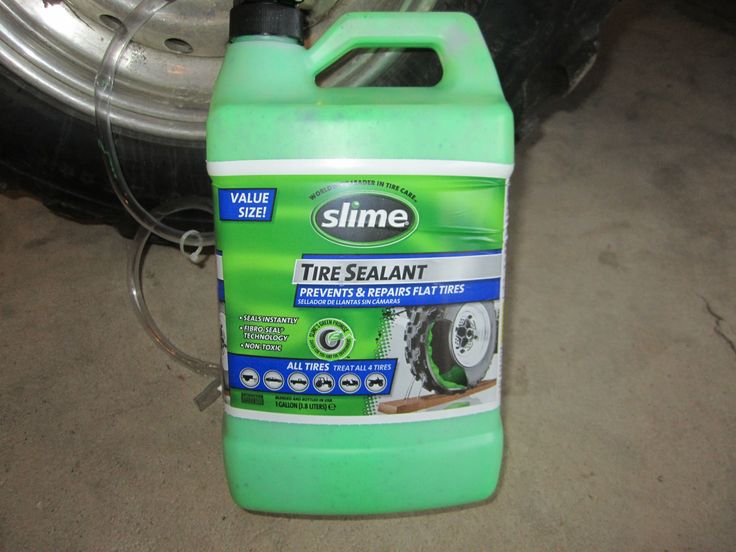 Hold the heat gun a few inches away from the plastic and keep it moving side to side the whole time.
Hold the heat gun a few inches away from the plastic and keep it moving side to side the whole time.
Any old heat gun will work for something like this. Heck, I’ve seen people use a propane torch with success. If you’re unsure what type of heat gun to use, check this Heat Gun from Amazon for starters.
That’s all there is to it. If you want to paint your ATV plastics a new color, check out this article: How To Prep And Paint ATV Plastics.
Sharing is caring!
ATV ball joints are a very important part of the suspension mechanism, both the life of the pilot and the lives of other participants in the race or walk very often depend on its serviceability. Therefore, the health of the ball bearings must be given increased attention, especially under the condition of an aggressive driving style on tracks with a high content of abrasive substances. The ball mechanism is quite simple: Read more
The ball mechanism is quite simple: Read more
ATV won't start? Don't know where to start troubleshooting? Then let's try to find out the main reasons why an ATV may refuse to start. Unfortunately, the equipment of any manufacturer sooner or later starts to act up, no one is safe from this, but finding a malfunction and starting an ATV that refuses to start is not so easy, especially if you are far away Read more
Brakes are a part of the ATV system that should be treated with special care, as regular inspection and maintenance of the ATV brake system will help you avoid accidents. Our article today will focus specifically on ATV brake hoses and their replacement. When inspecting the brake system, pay attention to the integrity of the hoses, a faulty brake hose can give Read more
 03.2017
03.2017 It is often heard from owners of ATVs with a chain drive that after a certain period of operation the chain began to fly off. This is most often due to chain stretching and the absence of a chain tensioner roller (there is no roller on some models of ATVs). It is also not uncommon to complain that the factory tensioner roller quickly wore out and ceased to perform its function properly. Quite Read more
Specifications of the ATV: Displacement: 150 cc. Power: 9.5 HP Engine type: Single-cylinder four-stroke Weight: 109 kg. Maximum speed: 70 km/h Engine start: electric / kickstarter Transmission: CVT Brakes: Front disc, rear drum Tires: 130/60-13 / 130/60-13 Weight: 109 kg. Carried weight: 150kg Dimensions (LxWxH): 1940x690x1139 Alarm: yes0013
As always, the most unpleasant things happen unexpectedly. Unfortunately, a flat tire is not uncommon when riding an ATV, and this little thing can really spoil the impression of the trip if you are not prepared for it in advance. Now there are a lot of products on sale with which you can cope with a puncture - these are special foam bottles, Read more
Now there are a lot of products on sale with which you can cope with a puncture - these are special foam bottles, Read more
The rear axle is one of the most problematic nodes on small displacement ATVs. Of course, the quality of the metal from which the assembly itself as a whole and its components are made is primarily affected. Yes, and the operation of an ATV most often comes with overloads in the area of \u200b\u200bthe rear trunk due to the presence of a second passenger on it or the presence of a hiking trunk. Jumping also affects Read more
I think everyone will be interested in how to replace conventional disc brake pads, which wear out very quickly when driving in especially difficult conditions (sand, water, snow with sand, mud) (100 km, or even less). The answer is immediately brewing that you need to put expensive reinforced pads !!!. They set it, and, as a rule, the result was not particularly inspiring, but they pay 2-3 Read more
If you are reading this article, it means that on one of the last trips your meeting with a log or a stone took place, and the body of the ATV received plastic damage. Do not despair. It is not difficult to repair the plastic body of an ATV. At first, we try to get the broken or cracked plastic parts of the body into place, which sometimes requires a second pair of hands. One holds, the second fixes Read more
Do not despair. It is not difficult to repair the plastic body of an ATV. At first, we try to get the broken or cracked plastic parts of the body into place, which sometimes requires a second pair of hands. One holds, the second fixes Read more
Silent block is a unit consisting of two metal bushings and an elastic insert (most often rubber) between them. Due to this element, oscillations and rattles are damped in the joints of parts. The silent block accounts for the lion's share of the shock loads received by the suspension. He has to restrain significant deformations simultaneously in various planes and directions. It must provide not only angular, but also radial and axial compliance. Read more
Diagnostics and repair of ATVs are important areas in the maintenance of motorcycles and all-terrain vehicles. It is important. So that the vehicle constantly remains on the move, does not have problems with movement and safety for the driver and passengers. Therefore, it is necessary to undergo technical inspection constantly, in time to change broken or failed spare parts and assemblies, to undergo an inspection of the condition of the machine, technical fluids.
Therefore, it is necessary to undergo technical inspection constantly, in time to change broken or failed spare parts and assemblies, to undergo an inspection of the condition of the machine, technical fluids.
We offer repair of ATVs in Krasnoyarsk and on favorable terms. There are low prices, promotions and discounts are constantly held. It is possible to order spare parts and accessories for tuning for any brands of all-terrain vehicles, snowmobiles and motorcycles. The employees of our workshop have extensive experience in servicing Yamaha, BRP, Suzuki, Honda and other brands, they immediately identify breakdowns and their causes. The use of modern computer equipment will allow you to detect problems in time and eliminate them. Departure to the client is possible.
When an ATV arrives at a service station, a complex diagnostic must first be carried out in order to identify all possible problems. It usually includes the following steps:

Every machine needs regular maintenance. Especially for ATVs, which often work in intensive operating conditions, which is called "wear and tear". therefore, attention to the technical side of their work needs a lot. Off-road can lead to frequent breakdowns, even if the car drives well and is not noisy - this does not mean that you can not visit the service. On the contrary, regular inspections will allow the iron horse to serve longer.
This should be especially remembered by beginners who pay more attention to tuning than repair. Unfortunately, all equipment is subject to wear and tear. When contacting a motorcycle service, you must have a service book with you, it also indicates the frequency of visiting the service station. If your equipment is older than 3 years, then it is better to undergo repairs a little more often. And you definitely shouldn't repair an ATV yourself, especially if you don't understand how it works. The risk of harm is much greater, and savings are unlikely to succeed. Recommendations of experts: contacting the service at least twice a year - in preparation for the active summer season and winter.
Recommendations of experts: contacting the service at least twice a year - in preparation for the active summer season and winter.
We offer quality service and competitive prices. The standard check includes:
Experienced technicians available for a wide range of repairs. You won't have to wait long - a large warehouse of spare parts and the necessary equipment will allow you to carry out repairs quickly. Qualified masters use modern equipment, including computer programs. Quality repairs are guaranteed - you can contact us with any problems and brands of ATVs and motorcycles.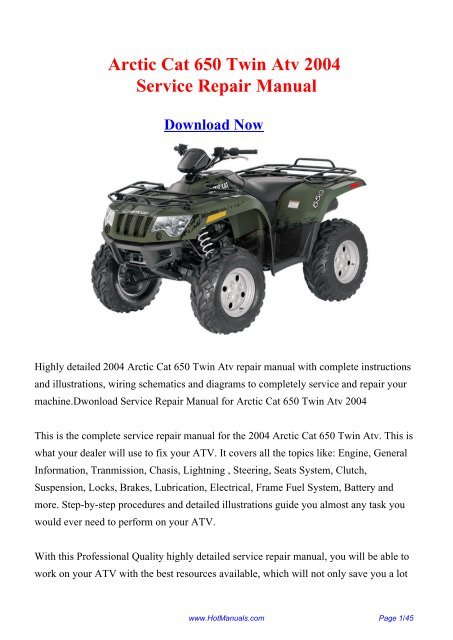
The heart of the machine requires careful attention. To extend its service life, it is better to use fuels and lubricants that have been tested and recommended by the manufacturer, and regularly conduct diagnostics. The main areas of repair:
It is subjected to crazy loads, so it can quickly fail. Breakage is better not to allow, because the equipment can fail at any time. Therefore, the load must be uniform. When repairing, specialists can replace bearings, hubs, levers, shock absorbers, bushings of levers and shock absorbers, ball bases. After that, alignment-adjustment is required.
Also an important part of the machine that needs attention. Among the main works, one can single out the replacement of the variator, its belt and cover, cardan and its cross, drive, CV joint and its anther, gearbox oil seals.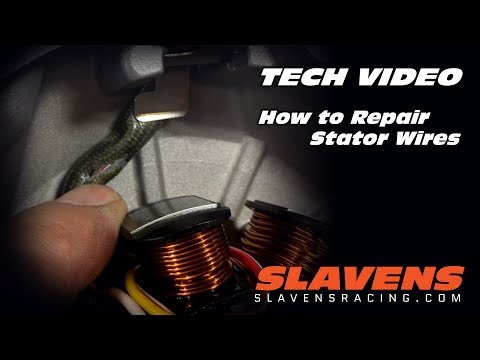
Electronics can fail in any technique. But our experts will quickly carry out maintenance of the battery, replace the ignition locks, starter, alternator and repair the wiring.
Alas, no one is immune from accidents, especially if the ATV is constantly used in extreme conditions. Customers may face problems with damage to the body, plastic, attachments, frame geometry. Therefore, after an accident, it is worth contacting professionals who can carry out serious work, including sawing and overcooking the frame.
Repair begins with a visual inspection, determining the degree of damage, the complexity of the work. Plastic parts and steering gear require the least time to eliminate shortcomings, most of all - the chassis and frame.
In addition to repair, we can carry out ATV tuning. We offer customers a large list of additional accessories and equipment that will help make your vehicle stand out, increase its efficiency and extend its life.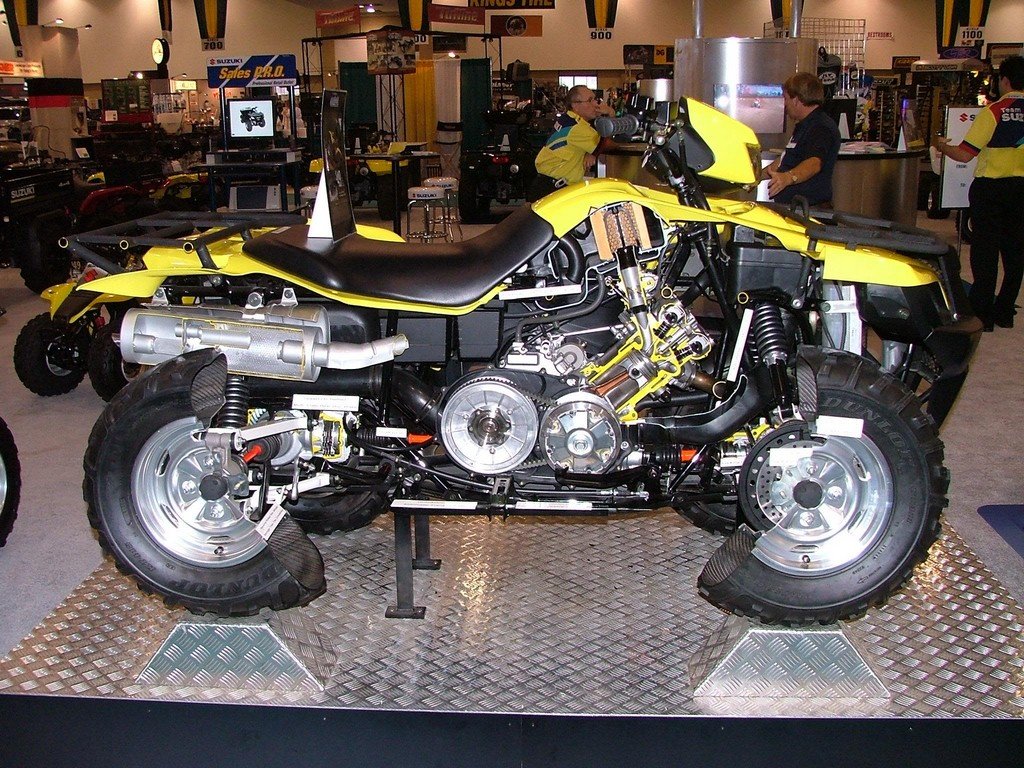 You can modify the nodes, install additional devices, tune the engine, or even paste over the entire body with a protective or carbon film. In the basic equipment, not all cars will be able to overcome deep fords, move through fallen trees, move through impenetrable swamps and ruts. But tuning will help to do this. Also among the useful additions is equipping cars with trailers, snow plows, devices for clearing the territory and even plowing the land.
You can modify the nodes, install additional devices, tune the engine, or even paste over the entire body with a protective or carbon film. In the basic equipment, not all cars will be able to overcome deep fords, move through fallen trees, move through impenetrable swamps and ruts. But tuning will help to do this. Also among the useful additions is equipping cars with trailers, snow plows, devices for clearing the territory and even plowing the land.
A full range of services for diagnostics, repair, replacement of parts and tuning in the company includes:

Tire service is also important in repair, because tires need to be changed constantly, they need to be balanced and changed when changing driving style or type of road. When changing tires, it is important to take into account the pressure, because it is different from a car. Therefore, when choosing any repair work, contact the professionals in their field. Recently, for the repair and tuning of ATVs, the service of pasting with a film - carbon, vinyl or ordinary protective film - has become popular. It can be glued to the entire body, individual parts, imitate textures and airbrushing, give a metallic sheen or camouflage vehicles. The transparent film will protect the surface from fading. Headlights can be glued with armored film so that they do not break or chip. For those who like to stand out, there is the option of pasting the body with matte carbon - it looks stylish, makes it easier to wash and clean.
To prolong machine life, keep rubber and plastic parts clean, change consumables and oil regularly, and lubricate suspension arms regularly.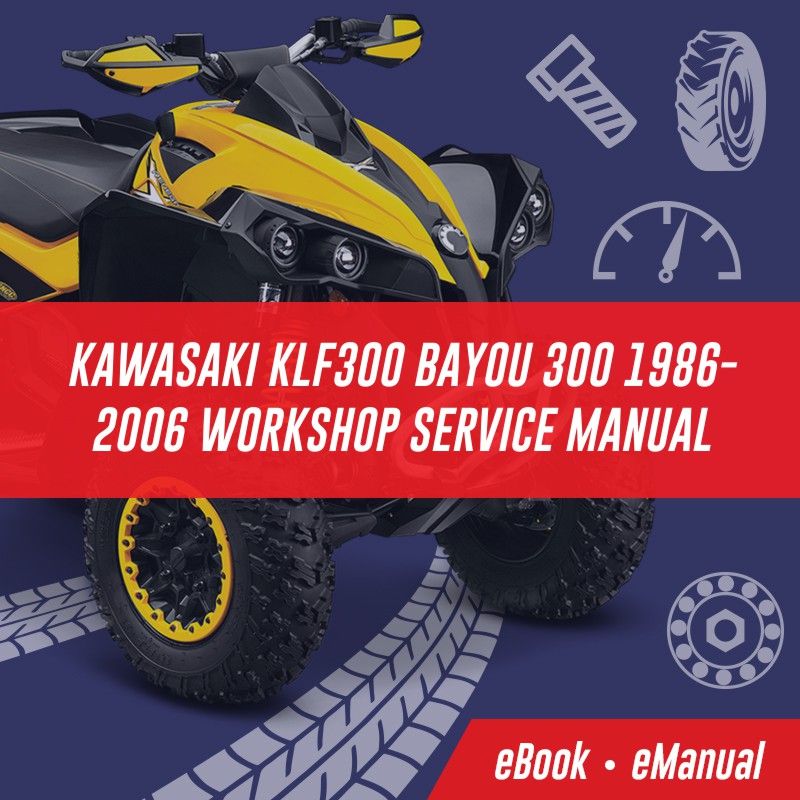 According to reviews, this will help to operate all-terrain vehicles longer.
According to reviews, this will help to operate all-terrain vehicles longer.
| No. | WORKS | BRP |
| 1 | Rewind winch | 500 |
| 2 | Winch repair with removal and rewind | from 3000 |
| 3 | Installing tracks on an ATV | 10000 |
| 4 | Rear backrest installation | 100 |
| 5 | Installing the windshield | 3000 |
| 6 | Arm and footpeg bottom protection installation | 3500 |
| 7 | Case installation | 600 |
| 8 | Installation of a wardrobe trunk with additional electrical elements | 1500 |
| 9 | Installing the winch in a regular place + wiring layout | 1500 |
| 10 | Installation of a non-standard winch + wiring layout | 3500 |
| 11 | Front/rear kengurin installation | 1000 |
| 12 | Installing heated handles | 2000 |
| 13 | Installing Heated Handles with Trigger | 2500 |
| 14 | Power body kit installation | from 2000 |
| 15 | Snow plow installation | from 2000 |
| 16 | Radiator extension installation | from 3500 |
| 17 | Installation of additional lighting | from 1500 |
| 18 | Handlebar guard installation | 300 |
| 19 | Installation of arch extensions | 1000 |
| 20 | Installing snorkels | from 4000 |
| 21 | Alarm setting | 3000 |
| 22 | Installation, activation of GPS/GSM tags | 500 |
| 23 | Seat heating installation | 2000 |
| 24 | Installing footrests for a second passenger | 2000 |
| 25 | ATV wash | 300 |
| 26 | Frame geometry restoration | from 20000 |
| 27 | Locksmith work | 500 |
| 28 | Cylinder head cover replacement | 500 |
| 29 | Oil change in internal combustion engine | 600 |
| 30 | Replacing the Recoil Starter | |
| 31 | Replacing the oil seal from the right crankcase cover | |
| 32 | Replacing the CPG without removing the engine | 10000 |
| 33 | Overhaul (ICE) with removal | 40000 |
| 34 | Overhaul (gearbox) with the removal of the internal combustion engine | |
| 35 | Overhaul (gearbox) with removal | 15000 |
| 36 | ICE valve adjustment | 2500 |
| 37 | Repair work with removal of the left engine cover | from 1500 |
| 38 | Repair work with the removal of the right cover (semi-crankcase) | from 1500 |
| 39 | ICE diagnostics | 1500 |
| 40 | Diagnostics of the fuel system carburetor, injection | 500 |
| 41 | Chassis and transmission diagnostics | 1000 |
| 42 | Electrical diagnostics | 500 |
| 43 | Rear gear oil change | 300 |
| 44 | Front gear oil change | 300 |
| 45 | Flushing the internal combustion engine when changing the oil | 300 |
| 46 | Grease packing oiler press | 100 |
| 47 | Complex | |
| 48 | Maintenance | 8500 |
| 49 | Replacement plastic 1 element | from 1000 |
| 50 | Plastic repair 1 element | from 1000 |
| 51 | Cooling fan replacement | 3500 |
| 52 | Air filter assembly replacement | 400 |
| 53 | Carburetor replacement + adjustment without add. |